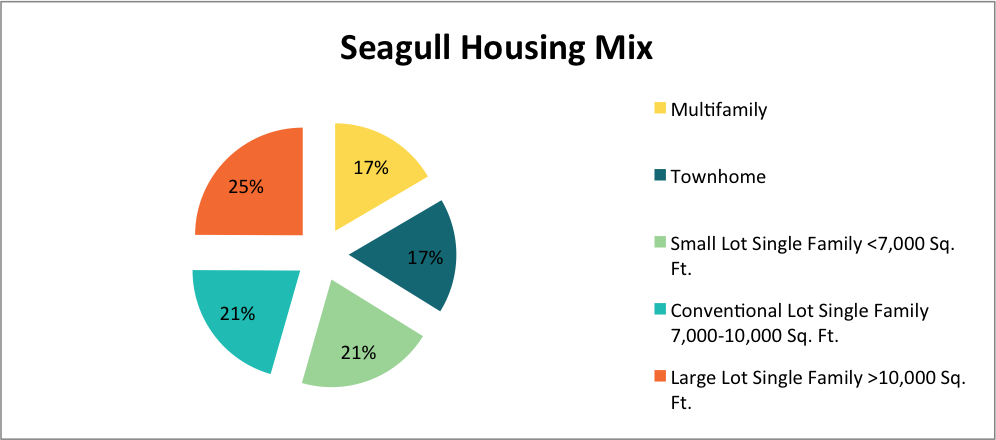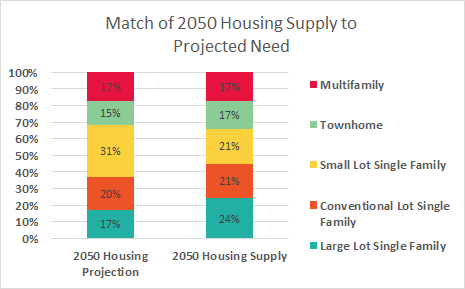The Story
By 2050, housing generally matches what Utahns need with a mix of single-family homes (with various yard sizes), townhomes, apartments, and condominiums. Though many communities allow a variety of housing types, few focus on locating housing close to or in mixed-use “centers” containing jobs, shopping, recreation, and access to public transportation. Only a few of Utah’s older mixed-use centers are revitalized, and few new mixed-use centers are created in the suburbs.
Transportation investments are spent on rail and buses, with somewhat more being spent on building new roads. Because housing, jobs, shopping, and public transportation are not located near each other, many people have to drive longer distances.
Parks and trails are expanded and, in some areas, are connected together.
Results
- Total new developed acres: 315,000
- Households within one mile of a center with daily services: 29%
- Housing mix: The mix of housing unit types generally matches what Utahns need.


- Total new local capital infrastructure costs: moderate, because growth is somewhat compact; roads, pipes, etc. do not have to stretch as far
- Wasatch Front households within a half mile of high-frequency public transportation: 46%.
- Transportation investment: mostly roads, moderate transit.
- 6.6% of commute trips on the Wasatch Front are on public transportation.
.jpg)
Background
How we build our communities and link them together affects our day-to-day lives. It determines how quickly and easily we can access work, shopping, and recreation and what mode of transportation we take to get there. How we design our communities also affects household costs, taxes, and other expenses.
When communities are organized so that people live close to shopping, jobs, and recreation, people need to drive less, which in turn reduces travel times, the cost of building and maintaining roads, household transportation costs (gas, car maintenance, etc.), and air pollutants.
When communities are more spread out, roads, pipes, and other utilities must stretch farther to reach each household and thus become more expensive to build and maintain. In addition, more spread out communities take away more of our farmland and open spaces.
The topic of Transportation and Communities partially or significantly affects Utah in many other topics:
- Agriculture is affected by how many farms must be sold to accommodate expanding communities.
- Air Quality is affected by how energy efficient our buildings are and our transportation choices.
- Recreation, as well as our health, is affected by whether or not we have walkable/bikable communities and sufficient trails and parks.
- Disaster Resilience is affected by how we construct buildings and whether or not we build in areas prone to earthquakes, floods, and fires.
- Housing and Cost of Living are affected by how well communities supply the types of housing Utahns want and can afford; by the cost of building roads, pipes, and other infrastructure, which impacts how much Utahns pay in taxes, utility bills, and fees; and by how easily Utahns can walk, bike, take public transit, or drive short distances—all of which impact household transportation costs.
- Energy is affected by the energy efficiency of our buildings and by our modes of transportation.
- Water is affected by how many farms are converted to homes and businesses; by how big our yards are and how we landscape; and by how much agricultural water is taken for homes and businesses.
- Jobs and Economy are affected by all of the above aspects of urban growth.


